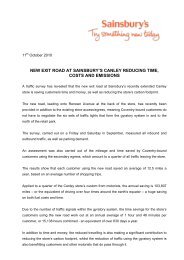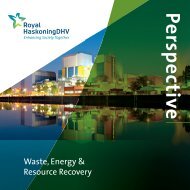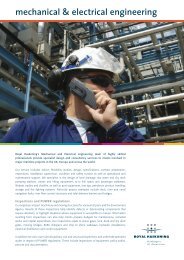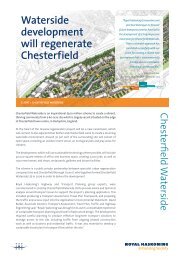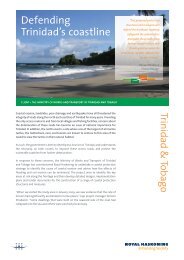Read the full Lakeside Energy from Waste Plant case study - Royal ...
Read the full Lakeside Energy from Waste Plant case study - Royal ...
Read the full Lakeside Energy from Waste Plant case study - Royal ...
Create successful ePaper yourself
Turn your PDF publications into a flip-book with our unique Google optimized e-Paper software.
The power of recycling<br />
client > BAM Nuttall<br />
”<strong>Royal</strong> Haskoning<br />
is incredibly<br />
knowledgeable not<br />
only in <strong>the</strong> design<br />
of such structures,<br />
but <strong>the</strong> recycling,<br />
environmental and<br />
renewable energy<br />
processes that take<br />
place within <strong>the</strong>m”<br />
Peter Golden, Project<br />
Manager, BAM Nuttall<br />
The <strong>Lakeside</strong> <strong>Energy</strong> <strong>from</strong> <strong>Waste</strong> (EfW) plant at Colnbrook near Slough in Berkshire<br />
is playing a major role in energy conservation by recycling domestic and commercial<br />
waste, and is set to generate 32Mw of power <strong>from</strong> both its material recycling<br />
facility and clinical waste incinerators, burning around 400,000 tonnes of waste<br />
every year.<br />
<strong>Royal</strong> Haskoning has been working with main contractor BAM Nuttall and process contractor Takuma<br />
to provide civil and structural engineering and architectural services, along with geotechnical and<br />
environmental design, for <strong>the</strong> plant which is based on <strong>the</strong> site of an existing clinical waste facility.<br />
Our brief has been to optimise <strong>the</strong> layout of <strong>the</strong> building and improve logistics and process flow<br />
to reduce construction costs where possible.<br />
The main challenges on this project were <strong>the</strong> groundworks and construction of a 32m high<br />
concrete waste bunker, 11m of which was below ground. The tight schedule of <strong>the</strong> project meant<br />
that <strong>the</strong> bunker had to be formed <strong>the</strong> quickest way possible so <strong>the</strong> traditional concrete jump<br />
forming shuttering approach – which would have taken between six and eight months – was out<br />
of <strong>the</strong> question.
The power of recycling<br />
The solution adopted was to utilise slipform construction, which is not generally used on structures of this nature but reduced <strong>the</strong><br />
construction time of <strong>the</strong> bunker to just three to four weeks, making substantial cost and time savings.<br />
The footprint of <strong>the</strong> subsurface area was marked out with Secant piles so <strong>the</strong> 11m pit could be excavated without <strong>the</strong> need for<br />
props or beams. Slipforming allowed continuous pouring around <strong>the</strong> clock, seven days a week and this continued right up to <strong>the</strong><br />
<strong>full</strong> height of <strong>the</strong> 21m wall above ground.<br />
The external structure encloses <strong>the</strong> main processing equipment in a striking facility that stands 50m high and features a complex<br />
roof, curved in two planes with a clear span of over 60m.<br />
The plant is currently in its final commissioning stages and is due to open in 2009.<br />
Contact:<br />
Mark Palmer<br />
T: +44 (0) 1733 33 6161<br />
E: m.palmer@royalhaskoning.com<br />
www.royalhaskoning.co.uk




